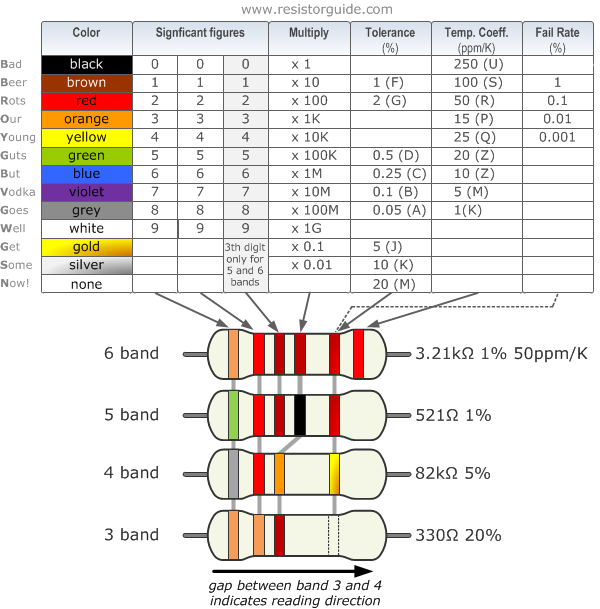

OHM RESISTOR COLOR CODE SERIES
The separation between the values is related to the tolerance so that adjacent values at the extremes of tolerance approximately just overlap for example, in the E6 series 10 + 20% is 12, while 15 − 20% is also 12. For 10% tolerance resistors the E12 series, with 12√ 10 as multiplier, is used similar schemes up to E192, for 0.5% or tighter tolerance are used. is used each value is approximately the previous value multiplied by 6√ 10. These values repeat for every decade of magnitude. Resistors use various E series of preferred numbers for their specific values, which are determined by their tolerance.
OHM RESISTOR COLOR CODE CODE
The standard color code per IEC 60062:2016 is as follows: Tight tolerance resistors may have three bands for significant figures rather than two, or an additional band indicating temperature coefficient, in units of ppm/ K.Īll coded components have at least two value bands and a multiplier other bands are optional. Resistors manufactured for military use may also include a fifth band which indicates component failure rate ( reliability) refer to MIL-HDBK-199 for further details. The values of components in surface mount packages are marked with printed alphanumeric codes instead of a color code. Advances in printing technology have now made printed numbers more practical on small components. Overheating of a component or dirt accumulation may make it impossible to distinguish brown from red or orange. However, there were drawbacks, especially for color blind people. In addition to the color code, these standards define a letter and digit code named RKM code for resistors and capacitors.Ĭolor bands were used because they were easily and cheaply printed on tiny components. The current international standard defining marking codes for resistors and capacitors is IEC 60062:2016 and EN 60062:2016. Originally only meant to be used for fixed resistors, the color code was extended to also cover capacitors with IEC 62:1968. In 1952, it was standardized in IEC 62:1952 by the International Electrotechnical Commission (IEC) and since 1963 also published as EIA RS-279. Though known most recently as EIA color code, the four name variations are found in books, magazines, catalogs, and other documents over more than 91 years. Over many decades, as the organization name changed (RMA, RTMA, RETMA, EIA) so was the name of the code. In 1930, the first radios with RMA color-coded resistors were built. In the 1920s, the RMA resistor color code was developed by the Radio Manufacturers Association (RMA) as a fixed resistor coloring code marking.

1945–1950īefore industry standards were established, each manufacturer used their own unique system for color coding or marking their components.


 0 kommentar(er)
0 kommentar(er)
